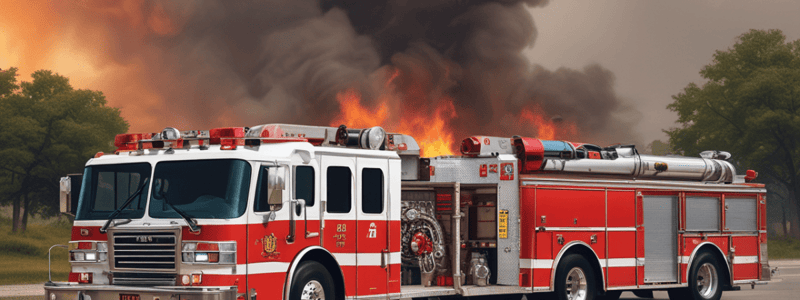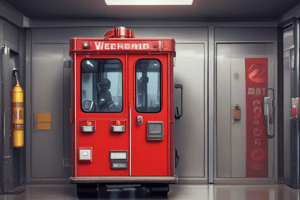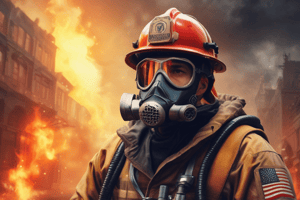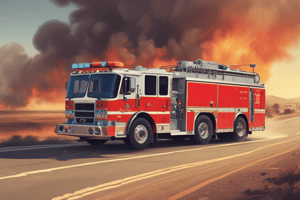Podcast
Questions and Answers
Who is primarily responsible for ensuring the safety of all persons riding and operating fire department apparatus?
Who is primarily responsible for ensuring the safety of all persons riding and operating fire department apparatus?
- The Labor/Management Safety Committee
- The Acting Company Officer
- The Company Officer (correct)
- The Fire Apparatus Operator
What is one of the responsibilities of the Company Officer regarding vehicle operation?
What is one of the responsibilities of the Company Officer regarding vehicle operation?
- Conduct regular vehicle maintenance checks.
- Make certain that seat belts are worn. (correct)
- Monitor the vehicle speed and advise if it is too slow.
- Ensure the sirens are turned off during emergency response.
Which of the following is NOT mentioned as a responsibility of the Company Officer?
Which of the following is NOT mentioned as a responsibility of the Company Officer?
- Operating the sirens during an emergency response
- Conducting pump and aerial training
- Monitoring vehicle speed
- Responding to citizen safety complaints (correct)
Which committee is responsible for jointly recommending the safety procedures?
Which committee is responsible for jointly recommending the safety procedures?
What must the Fire Apparatus Operator ensure during an emergency response?
What must the Fire Apparatus Operator ensure during an emergency response?
What should the Company Officer monitor regarding the Fire Apparatus Operator's driving?
What should the Company Officer monitor regarding the Fire Apparatus Operator's driving?
What is the primary purpose of the guidelines established by the Fire Department?
What is the primary purpose of the guidelines established by the Fire Department?
What type of training is the Company Officer required to conduct?
What type of training is the Company Officer required to conduct?
Which of the following is permitted for emergency vehicles responding to an emergency while operating emergency lights and siren?
Which of the following is permitted for emergency vehicles responding to an emergency while operating emergency lights and siren?
What should KCFD vehicle operators do when encountering a school bus with red warning lights?
What should KCFD vehicle operators do when encountering a school bus with red warning lights?
When may KCFD vehicle operators disregard regulations governing direction of movement?
When may KCFD vehicle operators disregard regulations governing direction of movement?
Which of the following is NOT an exception for emergency vehicles while responding to emergencies?
Which of the following is NOT an exception for emergency vehicles while responding to emergencies?
Under which condition can KCFD vehicle operators proceed without stopping?
Under which condition can KCFD vehicle operators proceed without stopping?
What must all KCFD vehicle operators maintain while operating their vehicles under exceptions?
What must all KCFD vehicle operators maintain while operating their vehicles under exceptions?
KCFD vehicle operators can exceed the speed limit only under which condition?
KCFD vehicle operators can exceed the speed limit only under which condition?
What is a requirement for KCFD vehicle operators when stopping is directed by law enforcement?
What is a requirement for KCFD vehicle operators when stopping is directed by law enforcement?
What should be done regarding seat belts when operating or riding in the fire apparatus?
What should be done regarding seat belts when operating or riding in the fire apparatus?
Which of the following is NOT a responsibility of the Fire Apparatus Operator?
Which of the following is NOT a responsibility of the Fire Apparatus Operator?
What is a key characteristic that the Fire Apparatus Operator must know about the apparatus?
What is a key characteristic that the Fire Apparatus Operator must know about the apparatus?
When driving in a non-emergency situation, which of the following actions should NOT be taken?
When driving in a non-emergency situation, which of the following actions should NOT be taken?
What is the purpose of using defensive driving techniques during non-emergency responses?
What is the purpose of using defensive driving techniques during non-emergency responses?
Which of the following should be secured before operating the apparatus?
Which of the following should be secured before operating the apparatus?
How should the apparatus be operated while responding to a non-emergency call?
How should the apparatus be operated while responding to a non-emergency call?
What is the main focus of the Fire Apparatus Operator's guidelines?
What is the main focus of the Fire Apparatus Operator's guidelines?
What should the apparatus do when responding in a non-emergency mode?
What should the apparatus do when responding in a non-emergency mode?
How should companies respond if they are in a non-emergency situation and an emergency arises?
How should companies respond if they are in a non-emergency situation and an emergency arises?
What defines a Non-Emergency Without Delay Response?
What defines a Non-Emergency Without Delay Response?
What must the Company Officer do if they decide to change the response mode due to road or weather conditions?
What must the Company Officer do if they decide to change the response mode due to road or weather conditions?
What is a characteristic of an Emergency Response move up?
What is a characteristic of an Emergency Response move up?
Which of the following describes a Non-Emergency Response?
Which of the following describes a Non-Emergency Response?
When may the Company Officer choose to change the company's response mode?
When may the Company Officer choose to change the company's response mode?
What is NOT a guideline for Non-Emergency Responses?
What is NOT a guideline for Non-Emergency Responses?
Which of the following incidents requires a non-emergency response from fire companies and Chief Officers?
Which of the following incidents requires a non-emergency response from fire companies and Chief Officers?
What action should be taken if a non-emergency alarm is found to pose a danger to life upon arrival?
What action should be taken if a non-emergency alarm is found to pose a danger to life upon arrival?
Which of the following scenarios should NOT be classified as an emergency response?
Which of the following scenarios should NOT be classified as an emergency response?
How should fire department vehicles be parked during incidents?
How should fire department vehicles be parked during incidents?
Which of the following instances qualifies for an emergency response?
Which of the following instances qualifies for an emergency response?
What is the procedure for a company arriving first on the scene of any incident?
What is the procedure for a company arriving first on the scene of any incident?
Which of the following is NOT a reason to dispatch a non-emergency response?
Which of the following is NOT a reason to dispatch a non-emergency response?
When dispatching responses, which option should be followed for natural gas leaks?
When dispatching responses, which option should be followed for natural gas leaks?
Study Notes
Purpose and Scope
- Aims to enhance safety for Kansas City Fire Department personnel and citizens.
- Guidelines applicable to all fire department personnel in Kansas City, Missouri.
Company Responsibilities
-
Company Officer Responsibilities:
- Ensure all personnel wear seat belts in vehicles.
- Oversee safe operation of fire apparatus by the operator.
- Monitor vehicle speed, particularly at intersections.
- Utilize sirens and air horns during emergency responses.
- Conduct regular training for pump and aerial operations.
-
Fire Apparatus Operator (FAO) Responsibilities:
- Complete daily or weekly apparatus checklists.
- Maintain control of the apparatus while driving.
- Secure all equipment before operation.
- Familiarize with the apparatus's specifications (weight, height, braking, etc.).
Response Modes
-
Non-Emergency Response:
- Conduct standard city or highway driving using defensive techniques.
- Comply with speed limits and operate without emergency lights.
- Slow acceleration and deceleration, using "Jacobs Brake" if weather permits.
-
Emergency Response:
- Exceptions in traffic regulations while responding or parked at emergencies include:
- Unauthorized parking.
- Proceeding through red lights after ensuring safety.
- Exceeding speed limits without endangering safety.
- Ignoring one-way regulations when safe.
- Operators must stop when directed by personnel, law enforcement, or at specific hazards (e.g., school buses, railroad crossings).
- Vehicles must be operated safely while maintaining response efficiency.
- Exceptions in traffic regulations while responding or parked at emergencies include:
Incident Response Procedures
-
Non-Emergency Incidents:
- Automatic alarms, smoke detectors, and natural gas leaks without fire are responded to non-emergency.
- Other incidents, such as working fires or injuries, require emergency response.
-
Response Upgrades:
- If new information indicates danger at a non-emergency alarm, Communications Center must be notified to upgrade the response.
Definitions
-
Non-Emergency Response:
- Driving with headlights on and in a safe, standard manner.
-
Non-Emergency Without Delay Response:
- Immediate response to incidents without delay, maintaining non-emergency driving conduct.
-
Emergency Response:
- Urgent response built on the premise of assessed risks and scenario demands.
Studying That Suits You
Use AI to generate personalized quizzes and flashcards to suit your learning preferences.
Related Documents
Description
This quiz covers the safety guidelines and responsibilities of personnel in the Kansas City Fire Department. It focuses on operational safety practices, including the use of seat belts and safe vehicle handling during emergency responses. Test your knowledge of these important protocols.




